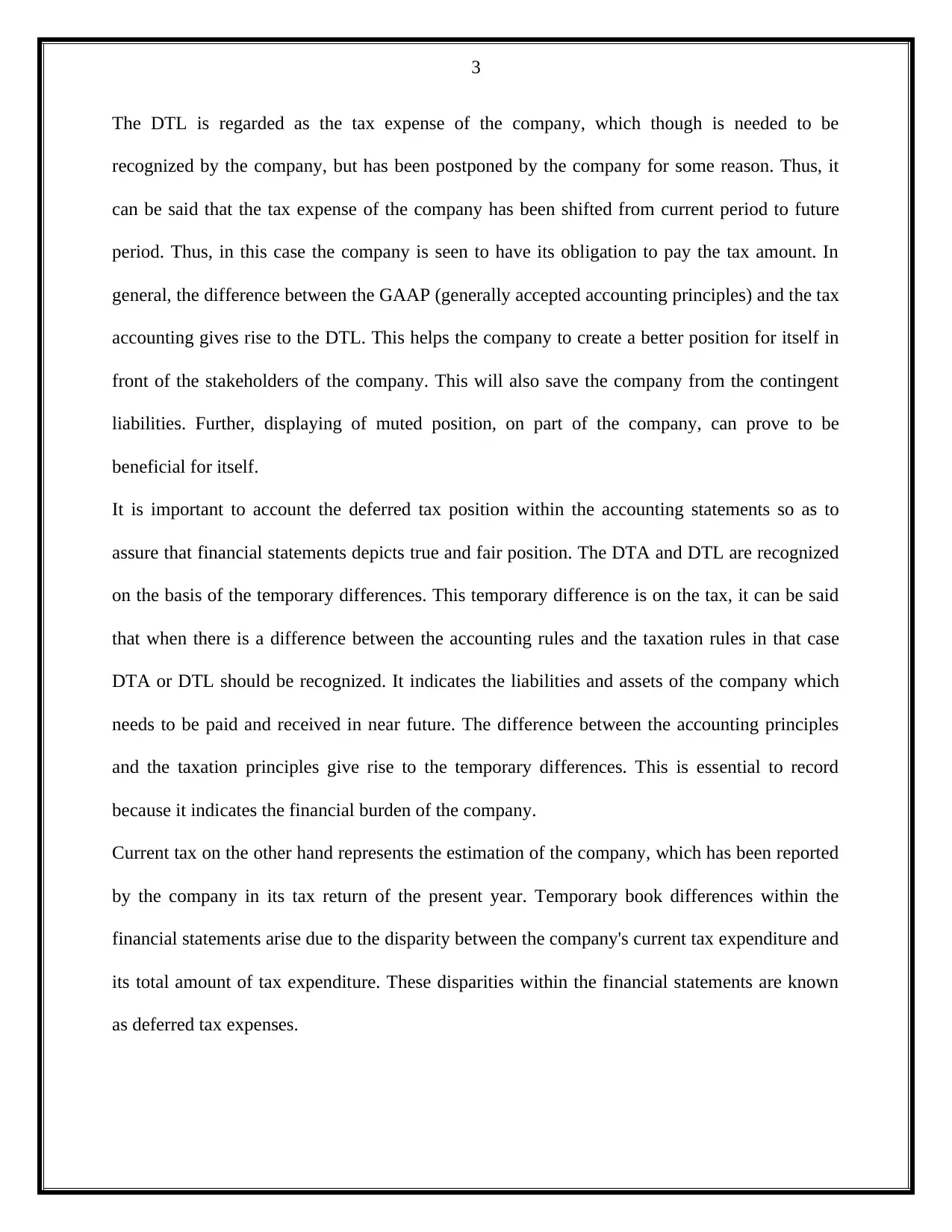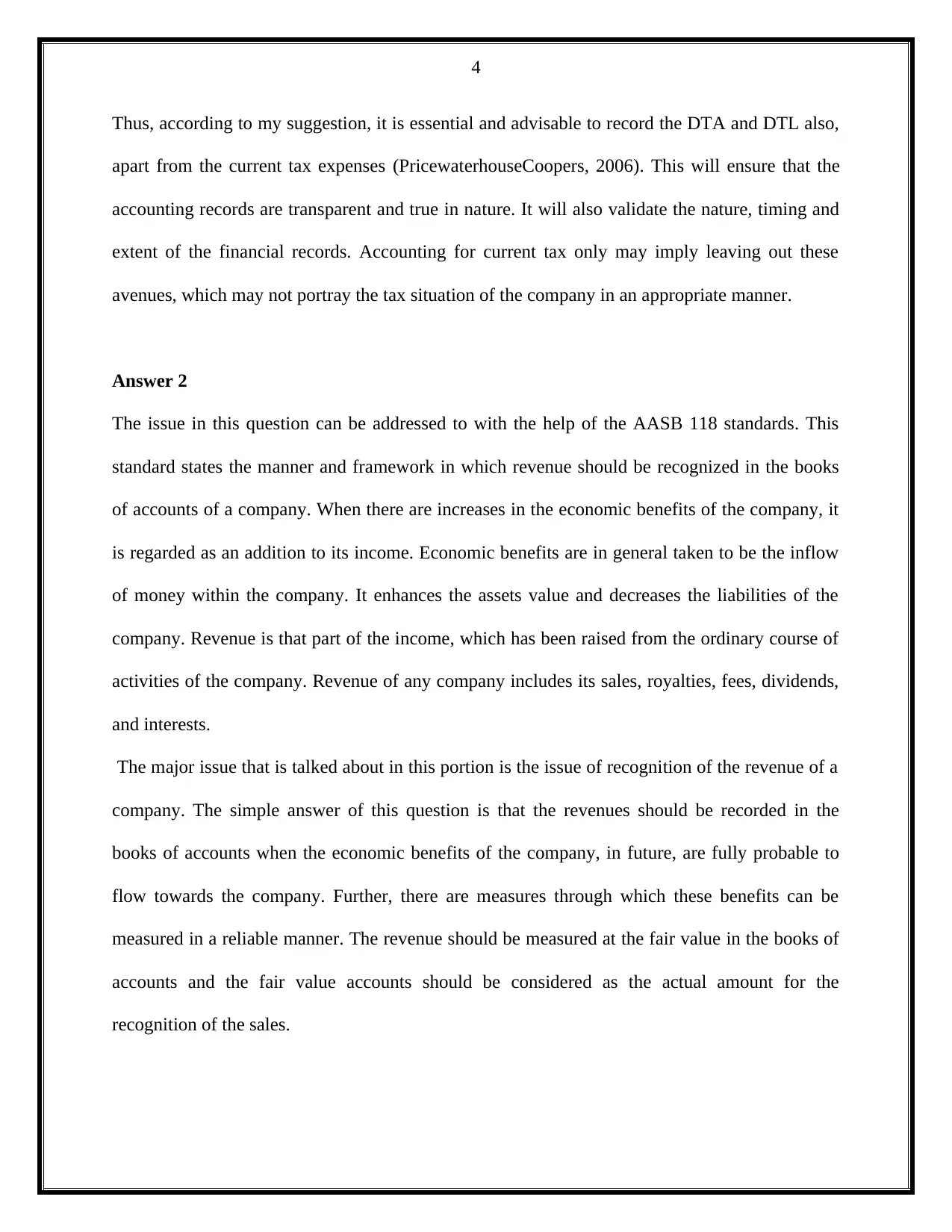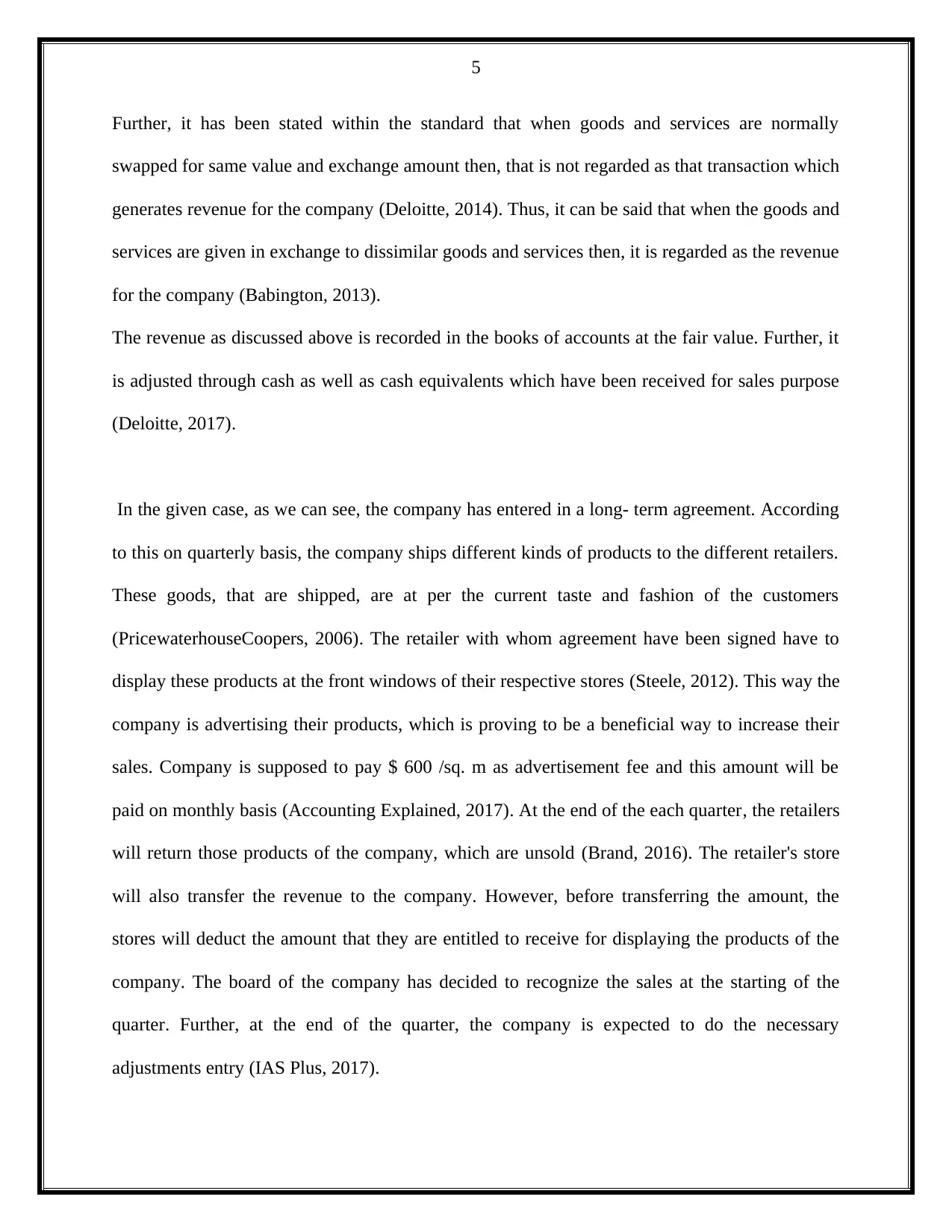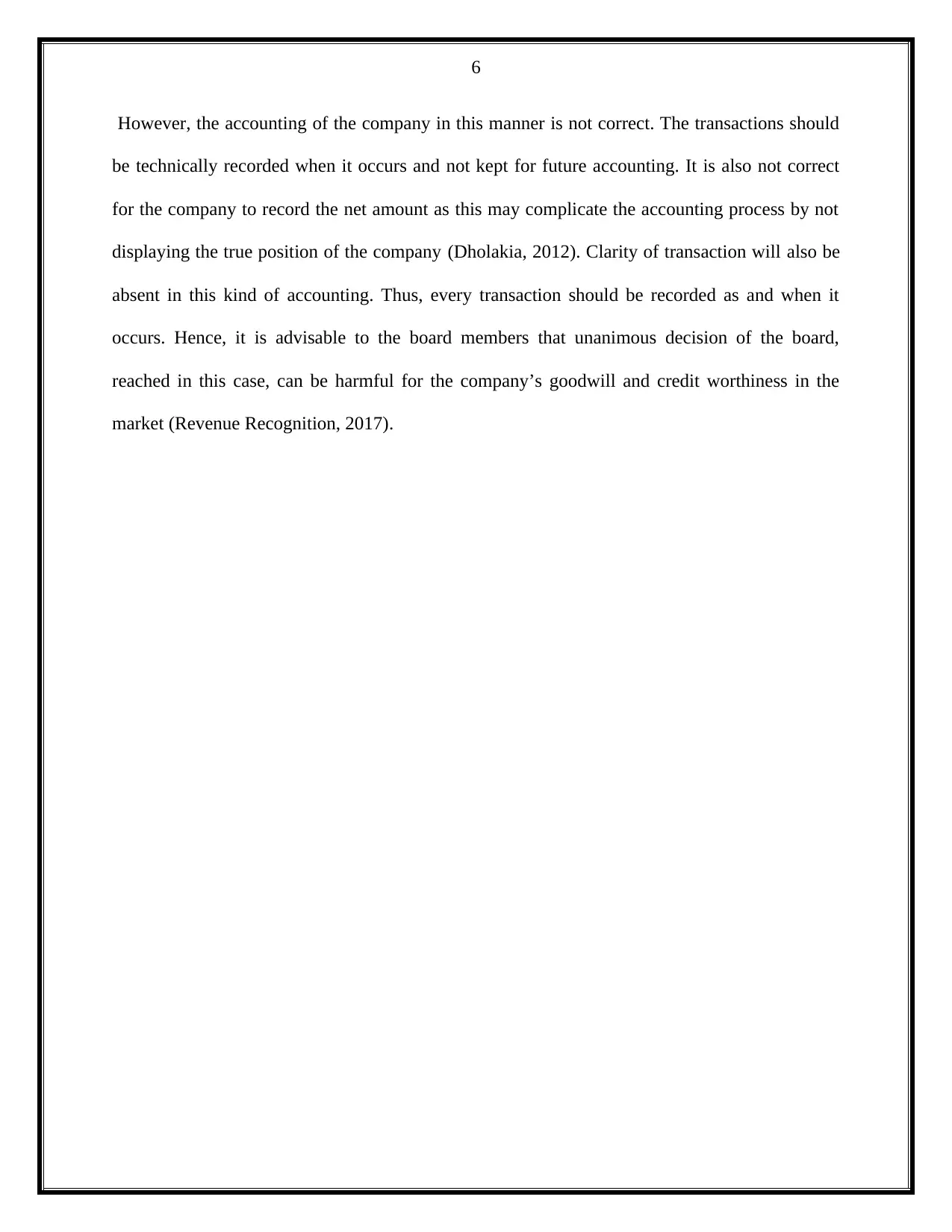Accounting Solutions Report
VerifiedAdded on 2020/03/04
|7
|1732
|54
Report
AI Summary
This report discusses accounting solutions related to the AASB and Corporations Act, focusing on deferred tax assets (DTA), deferred tax liabilities (DTL), and revenue recognition principles. It emphasizes the importance of accurately recording temporary differences and the implications of recognizing revenue at the correct time. The report also highlights the need for transparency in accounting records to reflect the true financial position of a company.

1
Report
Report
Paraphrase This Document
Need a fresh take? Get an instant paraphrase of this document with our AI Paraphraser

2
Thank you for the phone call. As per our discussions and agreement, I am mailing you the
accounting solutions that we have already discussed about, previously. The answers have been
given based on the AASB and the corporations Act.
Answer 1
I have gone through your mail and there you have discussed about the concerns of the directors
as portrayed in the Board meeting. There you told me that there are several issues to be looked
into:
Importance of temporary differences
There are substantial differences between the two accounting principles, namely the financial
accounting rules and that of the tax accounting rules. Due to the presence of substantial
inconsistencies between these two rules, some revenues and expenses are either under received
or over paid. The simple example of this can be as follows:
A company may have expense of 10000 monetary units, which it incurs in 2017 but it may so
happen that the income of the company is taxable income for the previous year. Thus, there may
be two types of the temporary accounts, one of which is that having future taxable amount and
another one being the one comprising of future deductible amount.
DTA relevance
A deferred tax asset is regarded as a situation where an enterprise has overpaid the tax expense
actually incurred. Thus, the balance sheet of the company, in this case shows advance tax
payment. This additional tax amount, however, is returned to the company in the next period. As
this amount is returned to the company, it is known as DTA.
DTL relevance
Thank you for the phone call. As per our discussions and agreement, I am mailing you the
accounting solutions that we have already discussed about, previously. The answers have been
given based on the AASB and the corporations Act.
Answer 1
I have gone through your mail and there you have discussed about the concerns of the directors
as portrayed in the Board meeting. There you told me that there are several issues to be looked
into:
Importance of temporary differences
There are substantial differences between the two accounting principles, namely the financial
accounting rules and that of the tax accounting rules. Due to the presence of substantial
inconsistencies between these two rules, some revenues and expenses are either under received
or over paid. The simple example of this can be as follows:
A company may have expense of 10000 monetary units, which it incurs in 2017 but it may so
happen that the income of the company is taxable income for the previous year. Thus, there may
be two types of the temporary accounts, one of which is that having future taxable amount and
another one being the one comprising of future deductible amount.
DTA relevance
A deferred tax asset is regarded as a situation where an enterprise has overpaid the tax expense
actually incurred. Thus, the balance sheet of the company, in this case shows advance tax
payment. This additional tax amount, however, is returned to the company in the next period. As
this amount is returned to the company, it is known as DTA.
DTL relevance

3
The DTL is regarded as the tax expense of the company, which though is needed to be
recognized by the company, but has been postponed by the company for some reason. Thus, it
can be said that the tax expense of the company has been shifted from current period to future
period. Thus, in this case the company is seen to have its obligation to pay the tax amount. In
general, the difference between the GAAP (generally accepted accounting principles) and the tax
accounting gives rise to the DTL. This helps the company to create a better position for itself in
front of the stakeholders of the company. This will also save the company from the contingent
liabilities. Further, displaying of muted position, on part of the company, can prove to be
beneficial for itself.
It is important to account the deferred tax position within the accounting statements so as to
assure that financial statements depicts true and fair position. The DTA and DTL are recognized
on the basis of the temporary differences. This temporary difference is on the tax, it can be said
that when there is a difference between the accounting rules and the taxation rules in that case
DTA or DTL should be recognized. It indicates the liabilities and assets of the company which
needs to be paid and received in near future. The difference between the accounting principles
and the taxation principles give rise to the temporary differences. This is essential to record
because it indicates the financial burden of the company.
Current tax on the other hand represents the estimation of the company, which has been reported
by the company in its tax return of the present year. Temporary book differences within the
financial statements arise due to the disparity between the company's current tax expenditure and
its total amount of tax expenditure. These disparities within the financial statements are known
as deferred tax expenses.
The DTL is regarded as the tax expense of the company, which though is needed to be
recognized by the company, but has been postponed by the company for some reason. Thus, it
can be said that the tax expense of the company has been shifted from current period to future
period. Thus, in this case the company is seen to have its obligation to pay the tax amount. In
general, the difference between the GAAP (generally accepted accounting principles) and the tax
accounting gives rise to the DTL. This helps the company to create a better position for itself in
front of the stakeholders of the company. This will also save the company from the contingent
liabilities. Further, displaying of muted position, on part of the company, can prove to be
beneficial for itself.
It is important to account the deferred tax position within the accounting statements so as to
assure that financial statements depicts true and fair position. The DTA and DTL are recognized
on the basis of the temporary differences. This temporary difference is on the tax, it can be said
that when there is a difference between the accounting rules and the taxation rules in that case
DTA or DTL should be recognized. It indicates the liabilities and assets of the company which
needs to be paid and received in near future. The difference between the accounting principles
and the taxation principles give rise to the temporary differences. This is essential to record
because it indicates the financial burden of the company.
Current tax on the other hand represents the estimation of the company, which has been reported
by the company in its tax return of the present year. Temporary book differences within the
financial statements arise due to the disparity between the company's current tax expenditure and
its total amount of tax expenditure. These disparities within the financial statements are known
as deferred tax expenses.
⊘ This is a preview!⊘
Do you want full access?
Subscribe today to unlock all pages.

Trusted by 1+ million students worldwide

4
Thus, according to my suggestion, it is essential and advisable to record the DTA and DTL also,
apart from the current tax expenses (PricewaterhouseCoopers, 2006). This will ensure that the
accounting records are transparent and true in nature. It will also validate the nature, timing and
extent of the financial records. Accounting for current tax only may imply leaving out these
avenues, which may not portray the tax situation of the company in an appropriate manner.
Answer 2
The issue in this question can be addressed to with the help of the AASB 118 standards. This
standard states the manner and framework in which revenue should be recognized in the books
of accounts of a company. When there are increases in the economic benefits of the company, it
is regarded as an addition to its income. Economic benefits are in general taken to be the inflow
of money within the company. It enhances the assets value and decreases the liabilities of the
company. Revenue is that part of the income, which has been raised from the ordinary course of
activities of the company. Revenue of any company includes its sales, royalties, fees, dividends,
and interests.
The major issue that is talked about in this portion is the issue of recognition of the revenue of a
company. The simple answer of this question is that the revenues should be recorded in the
books of accounts when the economic benefits of the company, in future, are fully probable to
flow towards the company. Further, there are measures through which these benefits can be
measured in a reliable manner. The revenue should be measured at the fair value in the books of
accounts and the fair value accounts should be considered as the actual amount for the
recognition of the sales.
Thus, according to my suggestion, it is essential and advisable to record the DTA and DTL also,
apart from the current tax expenses (PricewaterhouseCoopers, 2006). This will ensure that the
accounting records are transparent and true in nature. It will also validate the nature, timing and
extent of the financial records. Accounting for current tax only may imply leaving out these
avenues, which may not portray the tax situation of the company in an appropriate manner.
Answer 2
The issue in this question can be addressed to with the help of the AASB 118 standards. This
standard states the manner and framework in which revenue should be recognized in the books
of accounts of a company. When there are increases in the economic benefits of the company, it
is regarded as an addition to its income. Economic benefits are in general taken to be the inflow
of money within the company. It enhances the assets value and decreases the liabilities of the
company. Revenue is that part of the income, which has been raised from the ordinary course of
activities of the company. Revenue of any company includes its sales, royalties, fees, dividends,
and interests.
The major issue that is talked about in this portion is the issue of recognition of the revenue of a
company. The simple answer of this question is that the revenues should be recorded in the
books of accounts when the economic benefits of the company, in future, are fully probable to
flow towards the company. Further, there are measures through which these benefits can be
measured in a reliable manner. The revenue should be measured at the fair value in the books of
accounts and the fair value accounts should be considered as the actual amount for the
recognition of the sales.
Paraphrase This Document
Need a fresh take? Get an instant paraphrase of this document with our AI Paraphraser

5
Further, it has been stated within the standard that when goods and services are normally
swapped for same value and exchange amount then, that is not regarded as that transaction which
generates revenue for the company (Deloitte, 2014). Thus, it can be said that when the goods and
services are given in exchange to dissimilar goods and services then, it is regarded as the revenue
for the company (Babington, 2013).
The revenue as discussed above is recorded in the books of accounts at the fair value. Further, it
is adjusted through cash as well as cash equivalents which have been received for sales purpose
(Deloitte, 2017).
In the given case, as we can see, the company has entered in a long- term agreement. According
to this on quarterly basis, the company ships different kinds of products to the different retailers.
These goods, that are shipped, are at per the current taste and fashion of the customers
(PricewaterhouseCoopers, 2006). The retailer with whom agreement have been signed have to
display these products at the front windows of their respective stores (Steele, 2012). This way the
company is advertising their products, which is proving to be a beneficial way to increase their
sales. Company is supposed to pay $ 600 /sq. m as advertisement fee and this amount will be
paid on monthly basis (Accounting Explained, 2017). At the end of the each quarter, the retailers
will return those products of the company, which are unsold (Brand, 2016). The retailer's store
will also transfer the revenue to the company. However, before transferring the amount, the
stores will deduct the amount that they are entitled to receive for displaying the products of the
company. The board of the company has decided to recognize the sales at the starting of the
quarter. Further, at the end of the quarter, the company is expected to do the necessary
adjustments entry (IAS Plus, 2017).
Further, it has been stated within the standard that when goods and services are normally
swapped for same value and exchange amount then, that is not regarded as that transaction which
generates revenue for the company (Deloitte, 2014). Thus, it can be said that when the goods and
services are given in exchange to dissimilar goods and services then, it is regarded as the revenue
for the company (Babington, 2013).
The revenue as discussed above is recorded in the books of accounts at the fair value. Further, it
is adjusted through cash as well as cash equivalents which have been received for sales purpose
(Deloitte, 2017).
In the given case, as we can see, the company has entered in a long- term agreement. According
to this on quarterly basis, the company ships different kinds of products to the different retailers.
These goods, that are shipped, are at per the current taste and fashion of the customers
(PricewaterhouseCoopers, 2006). The retailer with whom agreement have been signed have to
display these products at the front windows of their respective stores (Steele, 2012). This way the
company is advertising their products, which is proving to be a beneficial way to increase their
sales. Company is supposed to pay $ 600 /sq. m as advertisement fee and this amount will be
paid on monthly basis (Accounting Explained, 2017). At the end of the each quarter, the retailers
will return those products of the company, which are unsold (Brand, 2016). The retailer's store
will also transfer the revenue to the company. However, before transferring the amount, the
stores will deduct the amount that they are entitled to receive for displaying the products of the
company. The board of the company has decided to recognize the sales at the starting of the
quarter. Further, at the end of the quarter, the company is expected to do the necessary
adjustments entry (IAS Plus, 2017).

6
However, the accounting of the company in this manner is not correct. The transactions should
be technically recorded when it occurs and not kept for future accounting. It is also not correct
for the company to record the net amount as this may complicate the accounting process by not
displaying the true position of the company (Dholakia, 2012). Clarity of transaction will also be
absent in this kind of accounting. Thus, every transaction should be recorded as and when it
occurs. Hence, it is advisable to the board members that unanimous decision of the board,
reached in this case, can be harmful for the company’s goodwill and credit worthiness in the
market (Revenue Recognition, 2017).
However, the accounting of the company in this manner is not correct. The transactions should
be technically recorded when it occurs and not kept for future accounting. It is also not correct
for the company to record the net amount as this may complicate the accounting process by not
displaying the true position of the company (Dholakia, 2012). Clarity of transaction will also be
absent in this kind of accounting. Thus, every transaction should be recorded as and when it
occurs. Hence, it is advisable to the board members that unanimous decision of the board,
reached in this case, can be harmful for the company’s goodwill and credit worthiness in the
market (Revenue Recognition, 2017).
⊘ This is a preview!⊘
Do you want full access?
Subscribe today to unlock all pages.

Trusted by 1+ million students worldwide

7
References
Accounting Explained, 2017. Revenue Recognition. [Online]
Available at: http://accountingexplained.com/financial/principles/revenue-recognition
[Accessed 03 March 2017].
Babington, J. T., 2013. U.S. GAAP Versus IFRS: Reconciling Revenue U.S. GAAP Versus IFRS:
Reconciling Revenue, s.l.: s.n.
Brand, H., 2016. IFRS in the US: The Investor's Perspective, s.l.: ACCA.
Deloitte, 2014. International Accounting Standards Committee (IASC). [Online]
Available at: http://www.iasplus.com/en/resources/ifrsf/history/resource25
[Accessed 10 12 2014].
Deloitte, 2017. IFRIC 15 — Agreements for the Construction of Real Estate. [Online]
Available at: https://www.iasplus.com/en/standards/ias/ias11
Dholakia, P., 2012. Perpetual Study of IFRS towards a True and Fair view of International
Accounting System, s.l.: s.n.
IAS Plus, 2017. IAS 18 - Revenue. [Online]
Available at: https://www.iasplus.com/en/standards/ias/ias18
[Accessed 03 March 2017].
PricewaterhouseCoopers, 2006. Similarities and Differences: A comparison of IFRS, US GAAP
and Indian GAAP, s.l.: PricewaterhouseCoopers.
Revenue Recognition, 2017. Revenue Recognition under International Accounting Standard 18 -
“Revenue” with Comparisons to US GAAP. [Online]
Available at: http://www.revenuerecognition.com/content/articles/9045
[Accessed 03 March 2017].
Steele, C. A., 2012. The Convergence of U.S. GAAP and IFRS:Revenue Recognition.
References
Accounting Explained, 2017. Revenue Recognition. [Online]
Available at: http://accountingexplained.com/financial/principles/revenue-recognition
[Accessed 03 March 2017].
Babington, J. T., 2013. U.S. GAAP Versus IFRS: Reconciling Revenue U.S. GAAP Versus IFRS:
Reconciling Revenue, s.l.: s.n.
Brand, H., 2016. IFRS in the US: The Investor's Perspective, s.l.: ACCA.
Deloitte, 2014. International Accounting Standards Committee (IASC). [Online]
Available at: http://www.iasplus.com/en/resources/ifrsf/history/resource25
[Accessed 10 12 2014].
Deloitte, 2017. IFRIC 15 — Agreements for the Construction of Real Estate. [Online]
Available at: https://www.iasplus.com/en/standards/ias/ias11
Dholakia, P., 2012. Perpetual Study of IFRS towards a True and Fair view of International
Accounting System, s.l.: s.n.
IAS Plus, 2017. IAS 18 - Revenue. [Online]
Available at: https://www.iasplus.com/en/standards/ias/ias18
[Accessed 03 March 2017].
PricewaterhouseCoopers, 2006. Similarities and Differences: A comparison of IFRS, US GAAP
and Indian GAAP, s.l.: PricewaterhouseCoopers.
Revenue Recognition, 2017. Revenue Recognition under International Accounting Standard 18 -
“Revenue” with Comparisons to US GAAP. [Online]
Available at: http://www.revenuerecognition.com/content/articles/9045
[Accessed 03 March 2017].
Steele, C. A., 2012. The Convergence of U.S. GAAP and IFRS:Revenue Recognition.
1 out of 7
Related Documents
Your All-in-One AI-Powered Toolkit for Academic Success.
+13062052269
info@desklib.com
Available 24*7 on WhatsApp / Email
![[object Object]](/_next/static/media/star-bottom.7253800d.svg)
Unlock your academic potential
Copyright © 2020–2025 A2Z Services. All Rights Reserved. Developed and managed by ZUCOL.





